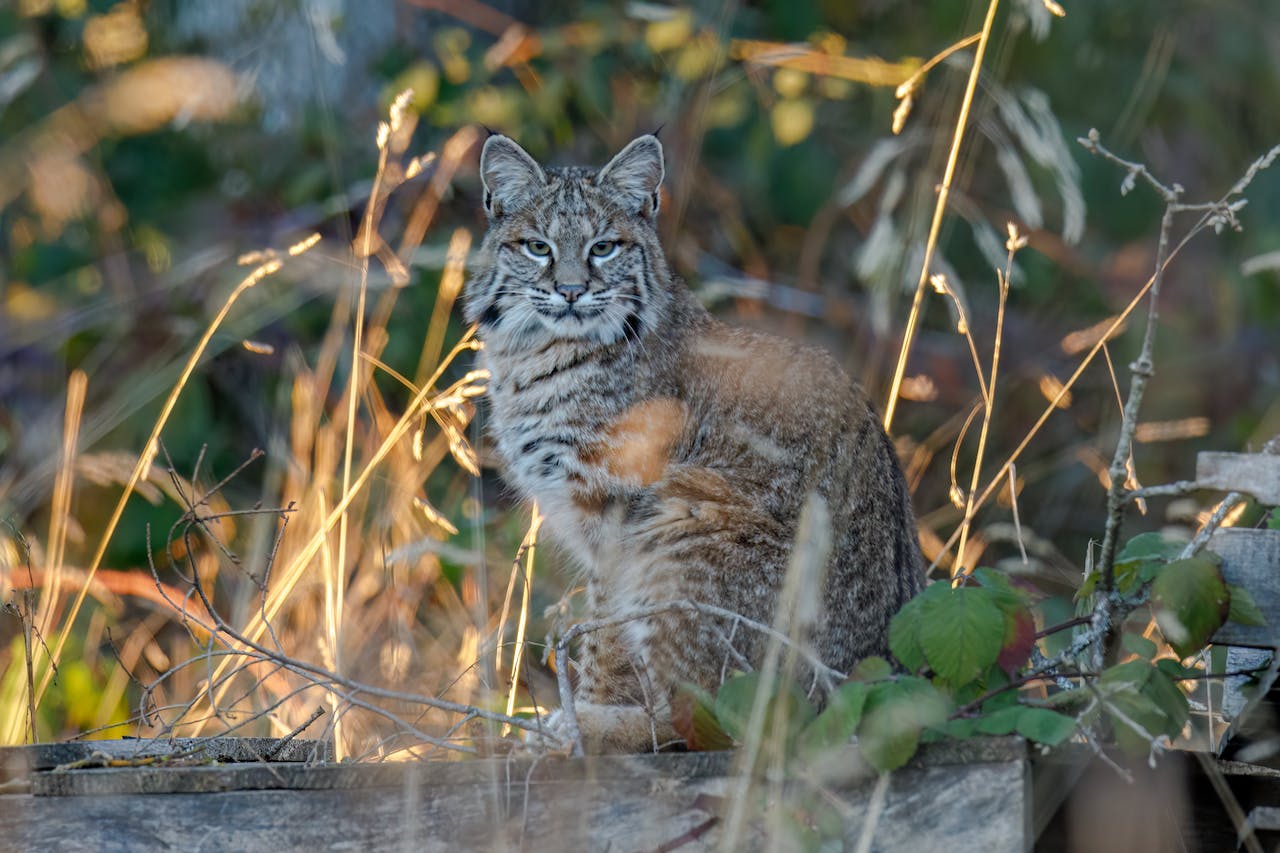Bobcats are wild cats that are closely related to Lynx since they fall into the same category. As a traveler who would like to explore wildlife destinations, you can find bobcats in North America, from Canada to Mexico.
They got their name from their have short, bobbed tails, distinctive black tufts on their ears, and spotted fur. Bobcats are elusive and nocturnal, which means that they are active mostly at night and avoid human contact.
Bobcats can live in different environments, such as big forest areas, deserts, mountainous areas, and even urban areas.
But what does a bobcat sound like? How can you recognize their sound or call if you ever hear them in the wild? And why do they make those sounds in the first place? In this article, we will answer these questions and more.
How to Identify Bobcat Sounds
Bobcats have different sounds, which greatly depend on their mood, situation, and reaction. Here are some of the most common bobcat sounds:
1. Purr
Purring is a low and continuous vibrating sound that bobcats and other cats make when they are content, relaxed, or grooming themselves. This is similar to the purr of your domestic cat at home, but sounds louder and deeper.
These animals are known to purr in order to bond with their mates or kittens and to show their satisfaction.

2. Meow
Just like your domestic cats, bobcats also meow. A meow sound is a short, high-pitched sound that animals like bobcats make when they are hungry, lonely, or in distress.
Bobcats have a more rough meow when compared to domestic cats.
3. Hiss
Yes, bobcats can produce the same hissing sound as a snake, but theirs is louder and more forceful. They make this sound when they are angry, scared, or threatened.
A bobcat will hiss to warn off potential predators or rivals and signal their readiness to fight.
4. Growl
Just like dogs and other cats in the wild, bobcats growl when they are very angry, scared, or feel threatened. Bobcats growl to intimidate predators or rivals and assert dominance over their territory.
A bobcat’s growl can be described as a low, guttural, and menacing sound that sounds intimidating to predators.
5. Snarl
Snarling is a bobcat’s way of expressing extreme anger and fear when they feel threatened. This is similar to the snarl of a dog but has a higher pitch.
Just like dogs, bobcats snarl to attack or defend themselves when they come across predators or rivals.

6. Yowl
Another sound bobcats make is a yowling sound. This is a long and loud sound that bobcats make when they are in heat or during mating season to look for a mate. They can also produce this sound when separated from their mate or kittens.
This is a way of revealing their location in order to locate or reunite with their mates or kittens.
7. Scream
Bobcats can also make a human-like scream when they are calling a mate. Their scream is more high-pitched and horrifying than that of humans.
You can listen to some examples of bobcat sounds below.

Why Bobcats Make Sounds?
Bobcats make sounds for various reasons, such as:
1. Communication
Since communication is important even for animals, bobcats use sounds to communicate with each other in the wild. They can produce the sounds mentioned in this article to convey their emotions, intentions, needs, and desires.
For example, bobcats purr to show their affection, meow to ask for food, yowl to find a mate, and growl to mark their territory.
2. Hunting
Bobcats use sounds when hunting their prey, which can be rabbits, rodents, birds, and sometimes deer. These sounds are meant to either locate, attract, or confuse their prey.
For example, a bobcat can meow to mimic the sound of a distressed rabbit in order to attract it or snarl to distract their prey.
3. Defense
They also use sounds to defend themselves against enemies, such as coyotes, wolves, bears, and sometimes humans. Trust me, as a cat person, their sounds can be quite intimidating to humans.
How to React to Bobcat Sounds
If you ever hear a bobcat sound in the wild, you might wonder how to react. Do not panic. Here are some tips to help you:
1. Stay calm
The first thing you should do is stay calm, since bobcats are usually shy and avoid humans. If you hear a bobcat sound, it does not necessarily mean that you are in danger.
What you should not do is panic and run away, as this might trigger the bobcat’s predatory or defensive instincts. Instead, you should stay calm and alert and identify the direction of the sound in order to move away to a safe location.
2. Keep your distance
It is important to note that these animals are territorial and are also protective of their mates and kittens. If you see a bobcat or come across their kittens, do not approach or disturb them.
You might be tempted to feed or pet them, but this is not a good idea because of their wild nature.
3. Make yourself big
What you can do to protect yourself when you encounter bobcats is make yourself big and loud by either raising your arms, waving your hands, clapping your hands, shouting, or throwing rocks or sticks.
This means you will have to stand your ground and maintain eye contact instead of turning your back to run.
4. Protect yourself
Since they are very powerful animals with teeth and claws, you can protect yourself by fighting back with any available weapon, such as a stick, a rock, a knife, or a pepper spray.
If you’re bitten or scratched by a bobcat in the wild, you need to seek medical attention as soon as possible.
Bottom Line
Bobcats are wonderful animals that have a variety of sounds. In this article, we have provided the sounds made by bobcats and a video of what they sound like.
These animals use sounds to communicate, hunt, and defend themselves against predators. Just like humans talk to show emotions, bobcats also use sounds to express their emotions, intentions, and needs.
We hope this article was helpful, and you must have learned something new about bobcats. Check out more articles like this below.
FAQs
How can you tell a lynx from a bobcat?
Bobcats and lynxes are closely related, but they have some features that differentiate them in some way. Bobcats have shorter legs, smaller feet, and shorter ear tufts than lynxes.
They also have more spotted fur, while lynxes have more solid fur. Bobcats live in warmer and drier climates, while lynxes live in colder and wetter climates.
How big are bobcats and how long do they live?
Bobcats are medium-sized cats that weigh between 10 and 40 pounds and measure between 26 and 41 inches in length, not including their tails. Their tails are between 4 and 7 inches long. Bobcats live between 10 and 14 years in the wild and up to 25 years in captivity.
What do bobcats eat and how do they hunt?
Bobcats are carnivores that hunt mostly rabbits, rodents, birds, and sometimes deer. Their hunting pattern includes stalking, ambushing, or chasing their prey.
Since they can run up to 30 miles per hour and jump up to 10 feet high, it is quite easy for them to follow up prey when they run.
How do bobcats reproduce and raise their young?
Bobcats mate between January and March and give birth between April and June. They have one litter per year, with an average of three kittens.
Their kittens are born blind and rely on their mother for up to two months for food and protection until they learn how to hunt and survive. They can stay with their mothers for up to one year before looking for their own territories.
why does a bobcat scream?
The bobcat scream is a mating call. They make this high-pitched screaming sound when looking for a mate or during the mating process.
Many individuals will describe it as sounding like a woman screaming or moaning in agony. This scream can be heard for miles.
All images used on this article are credited to pexels.com.

Hi, I’m Louis Ojibe, and I grew up around wildlife in Africa. I have always been fascinated by animals and nature across the world.
As a child, my parents used to take me to see wild animals like lions, elephants, gorillas, tortoises, and many others at our local zoo.











